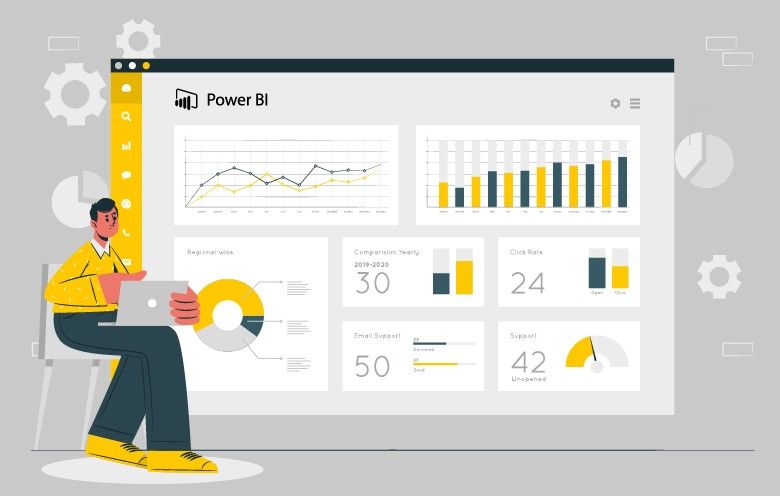Business Intelligence (BI) is a powerful tool that enables organizations to make informed decisions by providing access to valuable insights and data analysis. BI is a broad term that encompasses a wide range of technologies, methods, and practices that are used to collect, store, and analyze data from various sources. In this blog post, we will provide a complete overview of BI, including its definition, key components, benefits, and common use cases.
What is business intelligence?
Business Intelligence (BI) is a set of technologies, processes, and practices used to collect, integrate, analyze, and present data to help organizations make more informed business decisions. The goal of BI is to provide business users with a single source of truth, enabling them to make data-driven decisions that improve business performance.
How business intelligence works?
Business Intelligence (BI) typically works by following these steps:
- Data collection: The first step in BI is to gather data from various sources, such as transactional systems, databases, and external data sources. This data is then cleaned, transformed, and integrated into a central repository or data warehouse.
- Data modeling and warehousing: The data is then modeled and optimized for reporting and analysis. The data warehouse serves as a single source of truth, providing a consistent view of the data across the organization.
- Data analysis: Once the data is available in the data warehouse, it can be analyzed using various tools such as OLAP, data mining, and statistical analysis. This process is used to identify patterns, trends, and insights that can be used to improve business performance.
- Reporting and visualization: The results of the analysis are then presented in the form of reports, dashboards, and visualizations. Data Visualization tools such as Tableau, Power BI, Zoho Analytics, Looker Studio, etc makes it easy for business users to access and understand the information, and to make data-driven decisions.
- Monitoring and alerting: BI systems also enable users to monitor key performance indicators and set up alerts to notify when certain conditions are met. This allows organizations to stay on top of important changes in the business environment, and respond quickly.
What are the various BI methods to get started?
There are several methods to get started depending on your organization’s specific needs and resources. Some common methods include:
- Business Intelligence Services: Organizations can work with BI service providers to gain access to a range of BI capabilities, including data warehousing, reporting, and analytics. These services can be customized to meet the specific needs of the organization and can be provided on a project basis or as a managed service.
- Self-service BI: This method enables business users to access, analyze, and visualize data on their own, without the need for IT involvement. Self-service BI tools, such as Tableau, Power BI, Zoho Analytics and Looker, allow business users to create their own reports and dashboards, based on the data they need.
- Embedded BI: This method involves integrating BI capabilities into existing business applications, such as CRM or ERP systems. By embedding BI within these systems, organizations can provide their users with a seamless experience, where they can access data and insights without having to switch between different applications.
- Cloud-based BI: This method involves using cloud-based BI solutions, such as Azure, AWS or GCP, to store, process and analyze large datasets. Using cloud-based BI solutions can help organizations to reduce infrastructure costs and to scale their BI capabilities as their needs change.
How BI, data analytics, and business analytics work together?
Business Intelligence (BI), data analytics, and business analytics are all related but distinct fields that work together to help organizations make better use of their data.
Business Intelligence (BI) is a set of technologies, processes, and practices used to collect, integrate, analyze, and present data to support decision-making. The goal of BI is to provide a single source of truth and a consistent view of the data across the organization.
Data analytics is the process of examining, cleaning, transforming, and modeling data with the goal of discovering useful information, suggesting conclusions, and supporting decision-making.
Business analytics is the use of data, statistical, and quantitative analysis, explanatory and predictive models, and fact-based management to drive decisions and actions.
Together, they provide organizations with a comprehensive view of their data, which can be used to improve decision-making and optimize business performance. BI provides the data and the tools to make it accessible, data analytics is used to extract insights from the data, and business analytics is used to apply the insights to improve business performance.
The difference between traditional BI and modern BI
Traditional Business Intelligence (BI) and Modern BI are two different approaches to BI, each with its own set of capabilities and limitations.
Traditional BI:
- Is typically based on a centralized data warehouse that stores and manages large amounts of historical data
- Uses batch-oriented ETL (Extract, Transform, Load) processes to move data from transactional systems to the data warehouse
- Offers a limited set of data visualization and reporting tools
- Requires IT involvement to access and analyze data
- Focuses on retrospective reporting, historical analysis and performance monitoring
Modern BI:
- Is based on cloud-based data platforms and big data technologies
- Uses real-time data integration and streaming to move data from transactional systems to the data warehouse
- Offers a wide range of data visualization and reporting tools
- Allows business users to access and analyze data without IT involvement
- Focuses on predictive analytics, real-time monitoring, and proactive decision-making.
What are the benefits of business intelligence
Business Intelligence (BI) can bring many benefits to organizations, including:
- Improved decision-making: By providing a single source of truth and a consistent view of the data across the organization, BI enables users to make data-driven decisions that can improve business performance.
- Increased efficiency: BI can automate many manual processes and reduce the time and effort required to access and analyze data. This can result in increased efficiency, reduced costs, and improved productivity.
- Better customer insights: BI can be used to analyze customer data and gain insights into customer behavior, preferences, and needs. This can help organizations to improve customer satisfaction, increase customer loyalty and gain a competitive advantage.
- Better operational performance: BI can be used to analyze operational data and gain insights into operational performance. This can help organizations to identify areas for improvement and optimize operations, resulting in cost savings and increased productivity.
- Better strategic planning: BI can be used to analyze data, identify trends and make predictions. This can help organizations to better understand their business environment and to develop more effective strategies for the future.
In conclusion, Business Intelligence (BI) is a powerful tool that enables organizations to make informed decisions by providing access to valuable insights and data analysis. The goal of BI is to provide business users with a single source of truth, enabling them to make data-driven decisions that improve business performance. The benefits of using BI are numerous, including improved decision-making, increased efficiency, better customer insights, better operational performance, better risk management, better strategic planning and better compliance.
At Lets Viz Technologies, we understand the importance of making data-driven decisions for any business. Business intelligence is a vital tool that can help organizations make informed decisions.
We specialize in providing Business Intelligence services and expertise in tools like Tableau, Power BI, Zoho Analytics, and Looker Studio. Our team of certified Powerbi professionals, Tableau consultants & Zoho Experts has a wealth of experience in creating interactive dashboards, reports, and visualizations that make it easy to understand and act on data.
Our services include:
- Power BI consulting services, tailored to meet the specific needs of each client. We work closely with our clients to understand their business goals and objectives and then use our expertise to design and implement a Power BI solution that will help them achieve those goals.
- Tableau Consulting services, with our team of experts we can help you to transform your data into valuable insights and make better decisions.
- Zoho Analytics services, we can help you to automate your business processes and streamline your operations with the use of Zoho.
We stay up-to-date with the latest developments in these tools, ensuring that our clients always have access to the latest features and capabilities.





